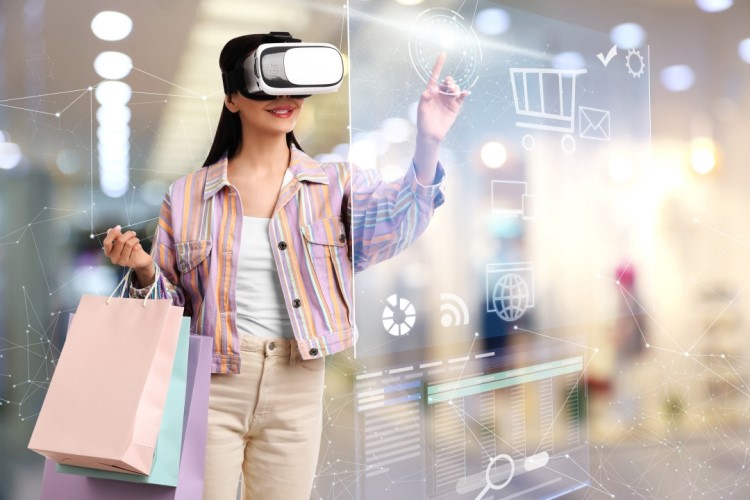
Retailers increasingly adopt these technologies to meet rising consumer expectations. You might have already noticed some brands using AR for virtual try-ons or interactive product displays. These tools not only capture your attention but also build confidence in your purchasing decisions. As a result, customers feel more satisfied and less likely to return items.
Moreover, the integration of virtual and augmented reality in retail provides valuable insights for retailers. By analyzing how you interact with products, they can refine marketing strategies and improve inventory management. This data-driven approach enhances overall operational efficiency. As you can see, the impact of these technologies extends beyond just the shopping experience. They represent a significant shift in how retail functions. The future looks promising for brands willing to embrace these innovations.
Enhancing Customer Experience
Virtual and augmented reality in retail transforms how you shop and interact with products. These technologies create immersive experiences that engage customers on a deeper level. For instance, VR allows you to step into a virtual store from the comfort of your home. You can browse products, explore different layouts, and even interact with virtual sales assistants. This level of interaction makes shopping more enjoyable and less stressful.
AR complements this experience by enhancing physical stores. With AR applications, you can use your smartphone to visualize how furniture fits in your space. You can see colors and styles in real-time, helping you make informed decisions. This technology reduces the uncertainty often associated with online shopping. Furthermore, AR can provide additional information about products when you scan them in-store, guiding your purchasing choices.
These immersive experiences lead to increased customer satisfaction. When you engage with products in a meaningful way, you feel more connected to them. This connection often results in higher sales and repeat customers. Retailers who implement virtual and augmented reality in retail not only attract tech-savvy shoppers but also create lasting impressions. As a result, they build brand loyalty and enhance their overall reputation in the market.
Virtual Try-Ons and Fitting Rooms
Virtual try-ons and fitting rooms are changing the way you shop for clothing, accessories, and cosmetics. This technology uses virtual and augmented reality in retail to create lifelike simulations. You can see how a dress fits your body shape or how a pair of sunglasses looks on your face. This feature eliminates the guesswork that often accompanies online shopping. By trying items virtually, you gain a better understanding of how they will look and feel.
The technology behind virtual try-ons involves advanced algorithms and 3D modeling. These systems analyze your body measurements and adjust the clothing or accessories to fit your unique shape. Additionally, facial recognition software allows you to see makeup shades and styles tailored to your features. This interactive experience enhances your confidence in purchasing decisions, reducing the likelihood of returns.
Moreover, retailers benefit significantly from implementing virtual try-ons. Studies show that using this technology can lower return rates substantially. Customers are less likely to return items when they can visualize how products will fit them beforehand. As a result, retailers save on shipping costs and restocking fees. This system not only improves customer satisfaction but also enhances operational efficiency. Overall, virtual try-ons represent a win-win for both consumers and retailers, making shopping more enjoyable and efficient.
Interactive Product Demonstrations
Interactive product demonstrations are transforming how you experience shopping. Retailers are now using augmented reality (AR) to create engaging demos for their products. With AR technology, you can visualize how a product works in real-time. This immersive experience allows you to interact with products as if they are physically in front of you. As a result, you gain a deeper understanding of their features and benefits.
For example, consider a customer looking to buy a new kitchen appliance. Through AR, they can see a virtual demo that shows how the appliance operates. You can watch the product in action and explore its various functions. This interactive approach not only enhances your understanding but also builds your confidence in making a purchase. You feel more informed and less uncertain about your decision.
Moreover, retailers benefit from these demonstrations as well. When customers engage with interactive product demos, they are more likely to convert. Higher engagement often leads to increased sales. By using virtual and augmented reality in retail, businesses create memorable shopping experiences. This strategy not only boosts customer satisfaction but also strengthens brand loyalty. Overall, interactive product demonstrations represent a significant step forward in retail, making shopping more informative and enjoyable.
In-Store Navigation and Assistance
In-store navigation can often feel overwhelming. Many stores have complex layouts, making it hard to find what you need. However, augmented reality (AR) applications are changing that experience. With AR, you can easily navigate stores and locate products without hassle. Your smartphone or a store-provided device can guide you through aisles in real time. You simply enter your desired item, and the app shows you the quickest route to it.
Additionally, AR can provide personalized recommendations based on your shopping habits. As you move through the store, the application might suggest complementary products. For instance, if you’re in the cereal aisle, you might see suggestions for milk or fruits. This feature helps you discover new items you may not have considered before. Thus, virtual and augmented reality in retail creates a more tailored shopping experience for you.
Moreover, these applications can enhance your overall satisfaction while shopping. When you find items quickly and receive relevant recommendations, your shopping trip becomes more enjoyable. This level of assistance not only saves you time but also encourages you to explore more products. Retailers benefit too, as happy customers are more likely to return. By integrating AR into the shopping experience, stores create a seamless, efficient environment that enhances your experience.
Data-Driven Insights and Analytics
Virtual and augmented reality in retail are transforming how stores operate. These technologies not only enhance customer experiences but also gather valuable data. For example, as you engage with VR or AR applications, they track your preferences and behaviors. This information helps retailers understand what products capture your interest.
Moreover, data collected through these technologies allows retailers to analyze shopping patterns. They can see which items are frequently viewed and which ones are often purchased together. This insight informs inventory management strategies, helping stores stock the right products. Consequently, retailers can reduce overstock situations while ensuring popular items are always available.
Additionally, AR and VR technologies can provide real-time analytics on foot traffic and engagement levels. Retailers can identify busy areas in the store and adjust layouts accordingly. By knowing where customers spend the most time, they can optimize product placement for maximum visibility. Therefore, the integration of virtual and augmented reality in retail not only enhances your shopping experience but also supports smarter retail strategies. This data-driven approach ultimately leads to improved customer satisfaction and operational efficiency.
Case Studies of Successful Implementations
Several retailers have successfully integrated virtual and augmented reality in retail, demonstrating innovative strategies and positive outcomes. For example, IKEA uses augmented reality through its app, IKEA Place. This app allows you to visualize how furniture fits in your home. By simply using your smartphone, you can place 3D models of furniture in your space. This interactive experience has significantly increased customer engagement and reduced return rates.
Another successful case is Sephora, which employs augmented reality in its Virtual Artist feature. This tool lets you try on cosmetics virtually. You can see how different shades and products look on your skin without physically applying them. This technology has boosted customer confidence in their purchases. As a result, Sephora reports higher sales conversions and increased customer satisfaction.
Moreover, Lowe’s has adopted virtual reality to enhance its customer experience. They developed a VR training program for employees to improve their product knowledge and customer service skills. This initiative has improved employee confidence and performance. Consequently, customers enjoy a more knowledgeable shopping experience.
These examples illustrate the powerful role of virtual and augmented reality in retail. By engaging customers in innovative ways, retailers can boost satisfaction and drive sales. The successful implementations of these technologies highlight their potential to reshape the retail landscape.
Conclusion
In summary, virtual and augmented reality in retail offer exciting opportunities for both retailers and customers. These technologies enhance the shopping experience by creating immersive interactions. Customers can visualize products better and engage more deeply with brands. As you have seen through various examples, successful implementations lead to increased customer satisfaction and reduced return rates.
Moreover, AR and VR tools can provide valuable data insights for retailers. By understanding customer preferences, you can tailor marketing strategies effectively. This adaptability is essential in a fast-paced retail environment.
As technology continues to evolve, the potential for virtual and augmented reality in retail will grow. Retailers who adopt these innovations can set themselves apart in a competitive market. By prioritizing customer experience and utilizing these advanced tools, you can foster loyalty and drive sales. The future of retail is bright, and embracing these technologies will be key to your success.


